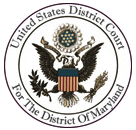United States District Court for the District of Maryland

The United States District Court for the District of Maryland (in case citations, D. Md.) is the federal district court whose jurisdiction is the state of Maryland. Appeals from the District of Maryland are taken to the United States Court of Appeals for the Fourth Circuit (except for patent claims and claims against the U.S. government under the Tucker Act, which are appealed to the Federal Circuit). Notable past judges of this district include William Paca, a signer of the United States Declaration of Independence. The United States Attorney for the District of Maryland represents the United States in civil and criminal litigation in the court. As of October 7, 2021, the U.S. attorney is Erek Barron.
Excerpt from the Wikipedia article United States District Court for the District of Maryland (License: CC BY-SA 3.0, Authors, Images).United States District Court for the District of Maryland
West Lombard Street, Baltimore Downtown
Geographical coordinates (GPS) Address Nearby Places Show on map
Geographical coordinates (GPS)
| Latitude | Longitude |
|---|---|
| N 39.286944444444 ° | E -76.617222222222 ° |
Address
Edward A. Garmatz Federal Courthouse
West Lombard Street 101
21201 Baltimore, Downtown
Maryland, United States
Open on Google Maps







